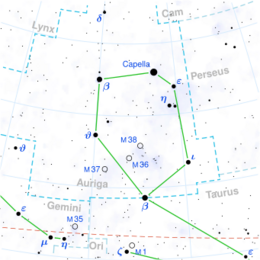Astronomy:V394 Aurigae
From HandWiki
Short description: Star in the constellation Auriga
| Observation data Equinox J2000.0]] (ICRS) | |
|---|---|
| Constellation | Auriga |
| Right ascension | 06h 06m 22.44529s[1] |
| Declination | +29° 30′ 44.6832″[1] |
| Apparent magnitude (V) | 6.01 - 6.11[2] |
| Characteristics | |
| Spectral type | M3II+F7V |
| U−B color index | 1.94 |
| B−V color index | 1.73 |
| Variable type | Semi-regular[2] |
| Astrometry | |
| Radial velocity (Rv) | -36.40 ± 0.18[3] km/s |
| Proper motion (μ) | RA: 11.503[1] mas/yr Dec.: −5.126[1] mas/yr |
| Parallax (π) | 3.7146 ± 0.0756[1] mas |
| Distance | 880 ± 20 ly (269 ± 5 pc) |
| Details | |
| Luminosity | 1075[4] L☉ |
| Temperature | 3589[4] K |
| Other designations | |
DO 11899, HIC 28930, PPM Star Catalogue 95388, STT 129, GC 7725, HIP 28930, SAO 77958, ADS 4673, GCRV 3829, HR 2146, AG+29° 663, IDS 06000+2931, TYC 1876-1774-1, BD+29° 1112, IRAS 06031+2931, UBV M 11751, CCDM J06064+2931, GSC 01876-01774, IRC +30137, YZ 29 2943, CSI+29 1112 1, HD 41429, 2MASS J06062243+2930445. | |
| Database references | |
| SIMBAD | data |
V394 Aurigae is a semi-regular variable star in the constellation Auriga. Its brightness varies between magnitudes 6.01 and 6.11,[2] so it is faintly visible to the naked eye under ideal observing conditions. Koen and Eyer found that the star's brightness, as seen by Hipparcos, varies with a period of 3.9 days.[6] Located around 730 light-years distant, V394 Aurigae shines with a luminosity approximately 1075 times that of the Sun and has a surface temperature of 3589 K.[4]
It is a double star: the secondary, designated V394 Aurigae B, is an eleventh-magnitude star with a separation of 10 arcseconds.[7]
References
- ↑ 1.0 1.1 1.2 1.3 1.4 Brown, A. G. A. (August 2018). "Gaia Data Release 2: Summary of the contents and survey properties". Astronomy & Astrophysics 616: A1. doi:10.1051/0004-6361/201833051. Bibcode: 2018A&A...616A...1G. Gaia DR2 record for this source at VizieR.
- ↑ 2.0 2.1 2.2 Watson, Christopher (4 January 2010). "V394 Aurigae". The International Variable Star Index. American Association of Variable Star Observers. http://www.aavso.org/vsx/index.php?view=detail.top&oid=4156.
- ↑ Gaia Collaboration (2018-04-01). "VizieR Online Data Catalog: Gaia DR2 (Gaia Collaboration, 2018)". VizieR Online Data Catalog 1345. Bibcode: 2018yCat.1345....0G.
- ↑ 4.0 4.1 4.2 McDonald, I.; Zijlstra, A. A.; Boyer, M. L. (2012). "Fundamental Parameters and Infrared Excesses of Hipparcos Stars". Monthly Notices of the Royal Astronomical Society 427 (1): 343–57. doi:10.1111/j.1365-2966.2012.21873.x. Bibcode: 2012MNRAS.427..343M.
- ↑ "/ftp/cats/more/HIP/cdroms/cats". Strasbourg astronomical Data Center. https://cdsarc.cds.unistra.fr/viz-bin/ftp-index?/ftp/cats/more/HIP/cdroms/cats.
- ↑ Koen, Chris; Eyer, Laurent (March 2002). "New periodic variables from the Hipparcos epoch photometry". Monthly Notices of the Royal Astronomical Society 331 (1): 45–59. doi:10.1046/j.1365-8711.2002.05150.x. Bibcode: 2002MNRAS.331...45K. https://academic.oup.com/mnras/article/331/1/45/1034740. Retrieved 23 November 2022.
- ↑ Dommanget, J.; Nys, O. (2002). "CCDM (Catalog of Components of Double & Multiple stars) (Dommanget+ 2002)". VizieR On-line Data Catalog: I/274. Originally Published in: Observations et Travaux 54 1274. Bibcode: 2002yCat.1274....0D. Vizier catalog entry
 |



